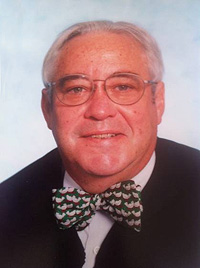 At the IFPS 40th Anniversary Celebration Dr. James Whittaker discussed the Family Preservation Practice Project at the University of Washington, School of Social Work and the National Family Preservation Educator’s Working Group and their relationship to the larger IFPS initiative:
At the IFPS 40th Anniversary Celebration Dr. James Whittaker discussed the Family Preservation Practice Project at the University of Washington, School of Social Work and the National Family Preservation Educator’s Working Group and their relationship to the larger IFPS initiative:
What was the outcome of our efforts in these various projects—one of which was a two-year specialization, featuring Homebuilders® in our {University of Washington School of Social Work] MSW curriculum?
The longer answer to that is in fact in a paper…which I did as a part of a seminar convened by Clark [the Edna McConnell Clark Foundation] and Chapin Hall Center for Children as a kind of point in time review of where things stood at the end of the 90s….
But for me, what I want to talk about briefly today, is an unanticipated outcome—something that I addressed only a little bit in my review—and that is that Homebuilders® really helped us as an institution, as a school of social work and, I think, as a profession to prepare for what is a reality today and that is evidence-based practice.
How did it do that? It did it the same way it did so many things—it changed the conversation.
We used to talk in social work about practice orientation—so we’d want to know, this person is psychodynamic, this person is family systems, this person’s behavioral. All of a sudden, and from the get-go, the discussion was about targeting.
I can remember Peter Forsythe [Edna McConnell Clark Foundation] saying, somewhat in jest: “For God’s sake, we ought to wait until someone’s at the door saying this child needs to be removed and send the Homebuilders® therapist in the back door of that house.”
We talked about the importance of identifying the key active ingredients in interventions:
- We talked about the value of time limits—you remember longer isn’t necessarily better
- Specifying outcomes
- The organizational infrastructure
- How you wrapped an effective intervention in a supervisory structure
- Caseload size—a hugely important issue
The bottom line is, I think, this gave us a head start in preparing for the major importance of our reality today which is evidence-based practice.
The paper Dr. Whittaker references was published in 2002 in the Journal of Family Strengths, The Elegant Simplicity of Family Preservation—Practice Legacies and Lessons. What Dr Whittaker wrote a dozen years ago is valuable today as we celebrate the 40th Anniversary of Intensive Family Preservation.
The following are a few key sections of the paper. We encourage you to read the full paper here. http://digitalcommons.library.tmc.edu/jfs/vol6/iss1/5
“If we take a child away from the mother, we willingly pay an asylum to care for him; the public funds pay for his support. Why should not the public funds pay it to the mother herself and keep the family together?”
Judge Julian Mack in his opening address to the 1912 Chicago Child Welfare Exhibit: “The Child in the City.”
Historical Antecedents of Intensive Family Preservation Practice
Judge Mack’s prescient question, posed near the beginning of a promise filled 20th century, awaits an adequate answer. Is it fundamentally a matter of values: a predilection for rescuing vulnerable children from the harmful influences of families and communities when things go terribly wrong? Or is it the continued elusiveness of what it actually takes to sustain and nurture families and in so doing assure the safety of children within them? For example, what is known with what degree of certainty about how to titrate the dosage of adequate income and other basic supports in combination with well defined, well timed, and well targeted social services to simultaneously preserve families and protect children? Or is it, after all, less a matter of either valuing families adequately, or knowing how to help them and more a problem of what Lisbeth Schorr (1997) describes as “scaling up”: developing the organizational infrastructure to deliver promising family centered intervention on a broad scale while at the same time creating the conditions for system change sufficient to insure that such innovations will endure?
A careful reading of the history of the “idea” of family preservation as well as an appraisal of the recent policy context for its adoption—as illuminated by Berry (1997), Schorr (1997), McCroskey and Meezan (1997), and others—suggests that all three explanations—dissensus on values, practice lacunae, and organizational complexities—may to a degree be valid. At a minimum, these and other trenchant commentaries such as those provided recently by Littell and Schuerman (1999) and Halpern (1999) suggest that any discussion of the “practice” of family preservation absent its historical/valuative roots and current organizational and policy context will be incomplete.
That said, this present paper will focus on some of the most vexing challenges of implementing family preservation practice, some of its enduring legacies as a practice modality, and some of the longer range problems in developing practice theory and application that it has illuminated. [Pages 1-2]
The Essential Components of Intensive Family Preservation Practice
As many commentators have noted, “family preservation” is not an entirely “new” idea. Its roots may be traced to some of the fundamental precepts of social treatment, and in its contemporary forms, it is easily traced to such pioneering demonstrations as the St. Paul Family Centered Project (Overton & Tinker, 1957). Its components are largely borrowed from other forms of practice, though its “newness” may well lie in the particular form and configuration in which they are offered. “Family preservation” at its core has most certainly been influenced by several sets of seminal ideas which have shaped the course of child welfare policy and professional practice in North America for at least the least the last two decades. These include
• The idea of the family as the ideal developmental context for the child.
• The notion of services as first and foremost family supportive and family strengthening.
A primary focus on meeting basic developmental needs of children in culturally acceptable ways, as opposed to identifying and treating child/family psychopathology.
• More focus on what might be termed an ecological perspective—looking at the effects of both proximate and distal environments on child outcomes—and moving from changing children and families from the “inside-out” to the “outside-in” (e.g., by working to create more supportive environments as well as by improving individual coping skills) [Pages 2-3]
Family Preservation Services
Intensive family preservation services, our focus in this present volume, are typically thought of as brief, highly intensive services generally delivered in the client’s home with the overarching goal of preventing unnecessary out-of-home placement.
There has been considerable federal, state, and local interest in these services, in part as a response to the escalating cost of out-of-home care, and, in part, because placement services were often offered before less dramatic alternatives were made available to families. Family preservation has been a central focus of federal child welfare reform legislation in 1980s and 1990s, as well as the focus of many state legislative initiatives and efforts by national associations and voluntary foundations to promote these services. Perhaps, not since the inauguration of Project Head Start has so much national attention been focused on a single service strategy.
The previously cited GAO report offers the following and somewhat expanded definition of family preservation:
Family preservation services are typically designed to help families alleviate crises that, left unaddressed, might lead to the out-of-home placement of children. Although more commonly used to prevent the need to remove children from their homes, family preservation services may also be a means to reunite children in foster care with their families. The goals of such services are to maintain the safety of children in their own homes, when appropriate, and to assist families in obtaining services and other support necessary to address the family’s needs. (GAO Report, 1995, p. 4)
What then are the defining characteristics/components of intensive family preservation services?
The first is a set of values and beliefs. Variously stated and as referenced earlier, they all speak to the notion of “family” as the ideal locus for child rearing and family support. Parents are viewed collegially, crises are viewed as opportunities for change, families are presumed to be doing the best they can under difficult circumstances, and caution is urged in labeling families as untreatable. While this particular set of values originates from the Homebuilders program, perhaps the best known of all of the family preservation models, the expressed values reflect the larger and more diverse array of family preservation programs as well (Kinney, Haapala, & Booth, 1991).
As Berry (1997) and others have noted, debates have raged over the defining characteristics of family preservation services. I would argue broad consensus exists presently on the following set: (1) imminent risk of placement; (2) immediate response; (3) highly flexible scheduling; (4) intensive intervention; (5) home-based services; (6) time limited and brief; (7) concrete and clinical services; (8) ecological approach; (9) goal oriented/limited objectives.
In support of these values for family and the practices through which they are operationalized, a considerable infra-structure of training capacity, state and local demonstration efforts, including dissemination of model programs such as Homebuilders and public education, was developed through the U.S. Children’s Bureau and key private organizations, such as the Edna McConnell Clark and Annie E. Casey Foundations. Taken together, these elements came to be seen as constituting the family preservation movement. At its core, this movement has been about system reform. Peter Bell, formerly President of the Edna McConnell Clark Foundation in New York, offers a succinct picture of what such a system would look like.
In our experience, social programs that work have a common core of characteristics. They understand, respect, and respond to the people being served. Effective programs increase their client’s sense of self- esteem, enlarge their capacities for self-help, connect them with a broader community, and deepen their stake in the community. These programs are usually “family like” in that they are personal and caring. They keep track of their clients; they do not lose them in a bureaucratic maze. Nor do they give up easily on people. They keep coming back at clients out of the conviction that the people they serve matter. (7959 Annual Report, Edna McConnell Clark Foundation) [Pages 5-7]
The Challenges of Implementing Intensive Family Preservation Practice
Strict Constructions and Liberal Interpretations
If consensus was easily attained on the value base of intensive family preservation, agreement on the actual specification of its essential components has proved to be more elusive. The more general question for all family oriented prevention services could be stated as follows:
What combinations of treatment/education/social support/concrete resources for what duration of time and intensity will produce varying outcomes of interest for differing types of children and families?
As noted earlier, some advocates, such as Mark Soler (1990) of the Youth Law Center, raised the concern early that model state legislation was too often silent on the specifics of intervention while eloquent on its values and principles, a theme echoed recently by Halpern (1999). While many compendia of exemplary family preservation programs exist, few of their components have been subject to rigorous empirical evaluation and are offered, typically, as a kind of consensus statement of “best practices” within a particular model or approach. Within the family preservation initiative, the absence of specificity, coupled with considerable resistance to the imposition of particular intervention models (such as Homebuilders), has led to what some describe as considerable “model drift” in application which translates into very real questions of treatment integrity in follow-up evaluations. Such critical features as caseload size, the teaching of certain cognitive- problem solving skills (such as anger management), the mobilization of social support including the provision of concrete resources await further research to ascertain their centrality and particular contribution to the overall intervention. Such questions are of course not unique to intensive family preservation.
In the area of placement services, for example, both residential treatment services for emotionally disturbed children and the newly emergent alternatives of “therapeutic fostering” (Hazel, 1989) and what are termed “wrap-around services” (VanDenBerg, 1993) present something like a series of “black boxes” as opposed to a well specified and empirically validated set of interventions. In the area of family involvement for children in placement, basic questions about the length, intensity, and nature of the intervention remain to be answered and many of these questions pose profound implications for budgeting as well as for treatment planning. For example, does “family intervention” mean:
• Periodic contact with an indigenous and minimally trained family worker with,
perhaps, linkage to mutual aid and self help?
• Parent skills training from a highly skilled parent educator in a group context?
• Structural family therapy with a master’s level trained family therapist?
• Occasional telephone consultation with a parent volunteer?
For intensive family preservation, similar questions can be raised with respect to such basic issues as the locus of service (client’s home vs. agency), the length of the service contact including the provision of follow-up or “booster shots,” the relative merits of service teams as opposed to single workers, and the theory base for the intervention itself (cognitive-behavioral, structural, person-centered, environment-centered). The core issue remains the identification of what are necessary and what are the sufficient elements of intensive family preservation required to achieve the desired outcomes of either avoidance of unnecessary placement, or re-unification while maintaining child safety? What, in other words, constitutes “reasonable efforts”? Gershenson’s observation of the 1980 reforms (P.L. 96-272) suggests why agreement on a well-specified model of intensive family preservation practice continues to elude us. “Reasonable effort,” he noted, “was more a hope than a designated program” (1995, p. 273). Re-Thinking Professional Helping
An oft repeated anecdote from the early days of the Clark Foundation initiative on family preservation concerned a certain casework eminence from the middle west who, on hearing what family preservation workers did and didn’t do, observed that at least it ought be clear that M.S.W. trained social workers did not do housework. A social worker in the audience immediately responded that only yesterday, she had helped her client clean her oven! What this anecdote captures are the myriad ways in which intensive family preservation challenged the conventional wisdom on what constituted “professional behavior” and extended its boundaries. While “beginning where the client is” had always been a precept of social casework, the simple fact of meeting in the client’s life-space meant oftentimes a blending of concrete and clinical helping in ways not typically taught in professional social work education. In some pilot training efforts, for example, the result was a focus on accomplishing simple home repairs (replacing broken window glass and weatherization) along with learning about anger management, crisis intervention, and parent-child communication. Similarly, the brevity of the intervention meant that conventional concerns about creating dependencies or worker self-disclosure receded in importance as workers struggled to help clients fashion case goals for the family that would result in stabilization and safety for all. The very process of assessment in family preservation was palpably different from that in most out-patient counseling services where clients often waited long periods to see a worker for the initial visit and longer still for the follow-up. Jill Kinney, one of the founding directors of Homebuilders, captured the differences perfectly: “We (Homebuilders) are there the first time long enough to hear the whole story and back soon enough so that it hasn’t changed” (personal communication). As intensive family preservation programs proliferated in the mid 1980s and early 1990s, issues of what constituted “professional behavior,” how linkages were to be made with other services and with mutual aid and other forms of informal helping, and what supports workers needed to respond effectively to different levels of client need came increasingly to the fore.
The “Scaling Up” Problem
As noted earlier, Lisbeth Schorr has written eloquently on the problem of “scaling up,” or as she puts it “spreading what works beyond the hothouse:”
Time was when scaling up from success was less an issue because it was generally assumed that successful programs contained the seeds of their own replication. The notion that promising models would automatically spread provided the rationale for funding of demonstration projects over the years. But these beliefs have not been supported by experience (1997, p. 24)
Schorr rightly directs our attention to what might be thought of as the organizational infra-structure for innovative program services, their stimulation, care, and nurture. For example, in family-oriented prevention, generally, the modal approach to implementation might best be described as a “train and hope” strategy. If intervention is the “black box,” training is the “black hole” in most social services departments. To the extent it exists, it is often didactic and diffuse as opposed to experiential, outcome driven, and skill oriented. More often than not, its content is driven more by the desires and interests of practitioners than either the demands of client families or relevant intervention research on “what works.” Moreover, much of training is patchwork—episodic with little attention given to follow-up, worker supports, and either training needs assessment or evaluation. A very few programs, such as the Teaching Family Model (Blase, Fixsen, Freeborn, & Jaeger, 1989), view training as the primary support to practitioners and have developed a fully integrated training/evaluation/career development continuum that works toward treatment integrity with the troubled youth served. Again, this program suggests more the exception than the rule. A great deal of attention needs to be paid to the careful and systematic development of a training capacity in family-oriented prevention if anything like full dissemination of promising intervention approaches is desired. Within the family preservation domain, Pecora, Fraser, Nelson, McCroskey, and Meezan (1995) offer many useful insights on quality assurance, development of training capacity, including the Quality Enhancement Systems and Training Program (QUEST), which includes standards for programs, therapists, intake workers, supervisors, and administrators (p. 81).
A related and serious problem is that prevention/intervention knowledge is often effectively “pigeon-holed” in a series of discrete program categories, with little opportunity for technology transfer or even the sharing of good ideas. Thus, in a large midwestern youth and family agency where I have consulted for over a decade, the family preservationists work and train separately from the aftercare workers and those providing therapeutic fostering, thus foreclosing the possibility of discovering that what makes for effective family preservation might also contribute to aftercare for youth returning to residential services—and vice versa. Isolation of programs, and particularly knowledge about intervention content, remains a major impediment to progress in prevention development at present. In addition to efforts at collaboration at the program level, I believe we sorely need some systematic and rigorous review of existing programs to try and identify a generic core of effective family work intervention (Whittaker & Pfeiffer, 1994). This, of course, leads us full circle to one of the dilemmas which faced the proponents of certain models of intensive family preservation for whom “generic” meant “homogenized” or “watered down” and who opted instead for model purity and avoidance of model drift. With the benefit of hindsight, I am convinced that this is a true dilemma with no easy solutions, but with profound implications for the kinds of evaluation challenges identified by Pecora, et al. (1995), Berry (1997), and other researchers.
Defining Meaningful Outcomes and The Problem of Targeting
At present, virtually all major systems providing services to children and families are re- thinking the issue of what constitutes “success.” One would like to report that this rush of interest in outcomes stems primarily from a desire to improve professional effectiveness, but while this might be a partial stimulus, the far greater impetus stems more from the accountants of social services than from its architects. The advent of managed care and managed revenue—tyingservice funding to tightly defined outcomes, specified time limited interventions, and constant monitoring—has made provider agencies and professionals acutely aware of the need to specify precisely the intended outcomes of their interventions and then to live with the results. In the intensive family preservation initiative, the apparently straightforward choice of avoidance of unnecessary out of home placement as the primary outcome of interest has caused major problems for researchers, program planners, and practitioners alike. It turns out that “placement” is a relatively low frequency event and therefore difficult to predict through precise targeting of services.
The dilemmas raised for researchers when placement avoidance is the primary outcome of interest are highlighted in the widely recognized Illinois study conducted by John Schuerman, Tina Rzepnicki, Julia Littell, and their colleagues (1994) at the Chapin Hall Center for Children at The University of Chicago. In brief, the Illinois study consisted of a sample drawn from the population of children known to the state and adjudged at “imminent risk of out-of-home placement.” Families were randomly assigned to one of two conditions: regular child welfare services (the control condition), or the intensive family preservation program (the experimental condition). While the study has been open to criticism on many grounds including the degree to which the treatment condition was faithful to the intensive family model, one of the most startling findings concerned the sampling frame itself. Examination of the control group (i.e., those not receiving intensive family preservation services) revealed that less than 7% of cases in the group were placed within 4 weeks of a case opening, and barely in excess of 20% after a year; 18% of cases in the comparison group were never opened for service (Schuerman, Rzepnicki & Littell, 1994). Moreover, it is now well known that in a great many jurisdictions “placement” as an outcome is subject to a wide range of factors independent of services: formal and informal administrative policies, the presence or absence of resources, and the discretion of juvenile court judges, to name a few.
Finally, the actual practice of intensive family preservation suggests that, for some families, there may be a kind of case finding function involved which uncovers the need for, say, a brief period of residential treatment for an emotionally disturbed child. Should “placement” in such instances automatically equate with “failure”? The backdrop for such discussions of the relative utility of “prevention of unnecessary out-of-home placement” as a criterion variable includes both the specific call on the part of some for a far greater emphasis on child safety as the primary outcome of interest, as well as a more general sentiment for focusing less on the physical locus of the child and more on his/her developmental trajectory and the state of the family’s functioning. Such findings are at least in part the reason that some researchers urge abandonment of “placement prevention” as the primary outcome of interest in family preservation in favor of a much broader array of child and family developmental outcomes. Wells and Tracy (1996), for example, argue strongly for a reorientation of intensive family preservation services within public child welfare toward a much expanded set of goals and the abandonment of placement prevention as the primary rationale for their existence. Littell and Schuerman sound a somewhat similar note:
Experience with family preservation programs raises questions about how to think about program success and failure… At the case level, when placement occurs, it is almost always thought to be in the child’s best interest; yet, in the aggregate, placements are viewed as something to be avoided. This conflict between clinical and policy goals muddies the interpretation of placement as an outcome. As in the past, there are differing views about what constitutes the best interests of children, but, clearly, placement prevention is not always in a child’s best interest. We think it will be more productive to focus on the goals of removing risks to children (child protection) and achieving continuity of care (permanency). (1999, p. 118)
Much of this discussion is evocative of the initial and negative outcome studies that followed the first wave of early intervention demonstrations, including many of the prototypes for Head Start (Lazar & Darlington, 1982). Here, senior investigators aided by foundation support were able to pool data from a number of controlled studies, conduct a follow-up, and offer cross study analysis of effects and their meanings. While the analysis found some evidence of educationally beneficial effects on children’s school performance, no evidence was found of significant improvements in intellectual functioning—an early hope for the demonstrations. The consortium of researchers concluded by cautioning against unrealistic expectations for limited educational intervention programs with low income disadvantaged children and their families (Lazar & Darlington, 1982). The effect of such careful re-analysis and reflection on policy makers cannot be underestimated. In the case of early intervention, it allowed for a broader interpretation of the aims of such programs as well as for crucial time to further develop and refine the interventions and build the political constituency necessary to insure their continued funding. Today, early childhood intervention programs in generaland Head Start in particular stand first in rank among all child welfare programs in terms of popular support.
Intensive family preservation, having raised the banner of “placement prevention” so high and so prominently as its primary criterion of success, is now in real danger of being prematurely dismissed. Faced with less than conclusive research findings and some tragic and well publicized child deaths, the initiative has recently been under serious attack in many states and localities and from some former advocates (Gelles, 1999). One can only hope that the same thoughtful reconsideration that followed the initial early childhood intervention demonstrations will occur for intensive family preservation as well.
Dealing with Danger and Difference
Another challenge accompanying the broad scale implementation of intensive family preservation programs has been adapting program models to meet the needs of particular communities of color and low income communities and the related challenge of adequately preparing workers to deal effectively with real and perceived dangers in the communities within which they work. A recent practice text offered the following observation on race, class, and environment:
The deep, intricate linkages between race, class, and environmental context can be seen in the ways that spatial segregation and surveillance reinforce wider social patterns of power, privilege, and access to resources…. Everyday lived experiences of racism are intensely spatial in nature, regardless of class or income. Despite the Civil Rights Act (1964) and three decades of civil rights activism, middle class blacks still describe a sustained pattern of discrimination in public places: they are shadowed by security guards in department stores, ignored by cab drivers, given poor service in restaurants and hotels, harassed by the police, and denied access to housing in elite white neighborhoods (Feagin & Sikes, 1994)…. Low-income blacks are even more vulnerable for discrimination, hostility, and surveillance, not only in public places clearly defined as white, but also in their own communities and neighborhoods. For residents of housing projects, for example, ongoing oversight by police, security guards, and representatives of various social service agencies undermines independence and fuels hostility and perceptions of differential treatment (Murray, 1995)…. Less obvious but equally salient is the growing evidence that environmental risks (e.g., toxic waste dumps, landfills, recycling plants, and garbage dumps) concentrate disproportionately in low income and minority communities.(Kemp, Whittaker, & Tracy, 1997, pp. 177, 178)
The net result is what Cutter (1995) describes as a “landscape of risk” (cited in Kemp, et al., 1997) which offers a powerful challenge to the operationalization of the core values of intensive family preservation enumerated earlier. Forexample, how well equipped are workers to assess the relative balance of risk and protective factors in low income communities of color and deal adequately with either?
Taken as a whole cloth, how much are the strategies and techniques of intensive family preservation oriented to changing the person, as opposed to changing the environment? How well are cultural and religious institutions (e.g., the black church community and faith-based helping) understood by the practitioners of family preservation? While important resources have been developed (Hodges, 1991) and much has been learned about cultural competence in training development in states like Michigan, much work needs to be done to fully render the core practices of intensive family preservation appropriate for the various communities of color and ethnicity in which they are practiced. Halpern (1999) challenges the appropriateness of even the bedrock notion of “partnership” in work with certain highly stressed families:
It is critical to refrain from viewing vulnerable families as all good or all bad. There is a difference between a parent who has little confidence he or she is doing a good job and one so overwhelmed, angry, and preoccupied that his or her children are in real danger. I question whether the latter can and ought to be a “partner” to the helping professional, let alone “help” with the work a service agency is doing in a particular neighborhood, (p. 259)
Preparing workers adequately for the variety of families they will work with, the novel situations they will encounter, and the often dangerous environments they and their families must traverse has always been at the forefront of training priorities in quality family preservation services. Homebuilders, for example, devotes considerable time to very practical information on “keeping people safe,” including predicting violence, gathering information on the neighborhood, traveling to the family home, and staying calm (Kinney, et al., 1991). Anecdotal evidence from present and former family preservation workers suggests to me, however, that more time and attention should be paid to the issue of worker safety. In addition to providing “street smarts” and personal safety tips, this means integrating knowledge across training areas so that workers see the connection between their understanding of a particular community and culture and their own comfort level and sense of safety. We expect a great deal from front line family preservation workers and as Halpern observes (citing Musick & Stott, 1990), we need to create a “chain of enablement” to support them: “Agencies that serve families need to be invested in and nurtured, so they in turn can invest in and nurture staff, who can in turn look after the families they serve” (1999, p. 259). This means, among otherthings, continued and sustained support and availability of supervision and on-the-spot consultation beyond the period of pre-service training and greater utilization of local community resources in worker preparation.[Pages 7-15]
The Legacy of Family Preservation Practice
Given all these challenges of implementing intensive family preservation practice, what is it that endures? Disappointing research results (Littell & Schuerman, 1999; Rossi, 1992) intensive media scrutiny following highly publicized child fatalities, and some very critical accounts of the family preservation initiative (Adams, 1994; Gelles, 1996) follow closely on the heels of a long planned decline in support from the Edna McConnell Clark Foundation, a prime mover in the initiative, more modest federal support, and much greater visibility for new forms of family centered practice, such as “family group conferencing” (Connolly & McKenzie, 1998). All of this seems to suggest that the “bloom is off the rose” with respect to family preservation.
Yet, in some important ways, family preservation continues to influence the wider field of child and family services beyond direct benefits to families currently served. First, and in spite of some strongly expressed views to the contrary (Gelles, 1999), there remains an enduring presumption for family as both the best guarantor of child safety and nurture for the long term, as well as a promising focus and locus for a wide variety of family supportive services. Schorr cites as hallmarks of successful programs those that “see children in context of their families” and “deal with families as parts of neighborhoods and communities” and offers numerous programmatic examples of community-anchored family programs that make a difference (1997, pp. 6,7). Similarly, Halpern (1999), while acknowledging the enormous complexity involved in designing effective and humane family-oriented services, nonetheless, sees the elements of a new template for services in the legacy of successful and unsuccessful community centered family support programs that have been launched over the last several decades:
We have now, as at other moments in the past, a number of promising ideas and elements to work with. We have plenty of best practice principles and interesting program and agency models. We know that the heart of services is caring relationships, not rules and procedures. We know that we must seek ways to provide help that do not undermine people’s sense of dignity. We are beginning to appreciate the need to help in ways that are empathic but do not insist on or assume a common interest between service providers and recipients. We are learning to design services that give at least a modest measure of voice and actual control to poor families being served. (1999, p. 254)
The lessons of genuine respect for families’ attempts to cope, the value on “situated practice” (Haraway cited in Kemp, et al., 1997, p. 7) including the preference for doing assessments in living rooms and kitchens as opposed to offices; the spirit of partnership; creative, flexible approaches to problem solving; and the value on community “connectedness” all remain vital. They constitute a body of knowledge slowly acquired from the St. Paul Family Centered Project (Overton & Tinker, 1957), Homebuilders (Kinney, et al., 1991), the Family Connections Project in Los Angeles (McCroskey & Meezan, 1997), the National Resource Center on Family Based Services in Iowa (1991), and a host of other family preservation projects current and past. They continue to inform new service initiatives as well as professional education for family and child practice in ways large and small. Many of us in social work education view the practice legacy of intensive family preservation as an important building block for a sequence of graduate practice education which prepares students for a wide range of settings and contexts, including schools, community agencies, and integrated service efforts.
Another area where family preservation has made a lasting contribution is in serving as a catalyst for a transformation of the professional helping role. One illustration of this transformation involves the longstanding emphasis in family preservation on the importance of combining concrete and clinical services in the unit of intervention, often provided by a single worker. From the earliest studies of family preservation, researchers have stressed the importance of tracking both concrete and clinical components in the overall intervention. Fraser, Pecora, and Haapala (1991), McCroskey (McCroskey & Meezan, 1997), Schuerman, et al. (1994), and other researchers have provided useful templates for tracking concrete services as well as a rationale for doing so. Their empirical emphasis buttresses a long standing view of the practitioners of family preservation that helping a family make order in a chaotic household and attending to such basic needs as food, heat, clothing and shelter often is a necessary prerequisite to other more clinically focused interventions as well as setting an all important relationship base for other forms of helping. Kinney, Haapala, and Booth state clearly the basic rationale for inclusion of concrete services:
We help families with basic needs because they will not be able to care adequately for children without mastering these areas. They will not be able to concentrate on more abstract skills such as parenting and communications unless basic needs have been met. (1991, p. 117)
Nelson and Allen (1995) suggest the transformative nature of such emphases on the fundamental definition of the professional helping role:
Respect for family strengths and integrity requires a concomitant redefinition of professional roles so that they are more responsive to family needs. Professionals, no longer seen as the experts responsible for “fixing” families, use their skills and knowledge to increase the options families have for dealing with problems and help remove barriers to change. With a focus on the whole family and access to a comprehensive array of services and resources, professionals are freed from narrow role definitions and are able to be more creative in addressing family needs. (1995, p. 112)
A third area of contribution concerns the contextualization of family centered practice. Adherence to the basic values of intensive family preservation, as well as to its in-situ practices leads, ineluctably, to a more ecologically focused, contextually grounded form of practice. Currently, the most widely promoted legatee of the intensive family preservation tradition, “multi-systemic treatment,” extends the foci of earlier models to peer group, neighborhood, school, and community in ways that are utterly consistent with such first generation approaches without explicitly adopting either the rubric of “intensive family preservation” or its familiar outcome of “placement prevention” (Henggler & Borduin, 1990, 1999).
Buttressed by a growing body of empirical findings and the blessings of NIMH and significant opinion makers in the youth and family services field, MST is presently undergoing a wide ranging expansion into a variety of youth service, child mental health, and family service domains. This expansion is but one example of an incipient movement within the human services to fundamentally restructure “direct practice” to reflect more of the environments in which clients actually reside, and/or which affect their life circumstances profoundly (Adams & Nelson, 1995; Kemp, et al., 1997). Coupled with a new emphasis on “resilience and risk,” such ecologically oriented approaches suggest both a new template for what has typically been described as “direct” or “interpersonal practice” and new foci for the training and education of human service professionals by providing a “third way” (i.e., one distinct from either personalistic therapies or community organization). Intensive family preservation practice is, at least in part, responsible for this shift.
Finally, and in a curious way, the unhinging of intensive family preservation from its overriding focus on “placement prevention” perhaps has had a liberating effect in that it has encouraged the creative uses of the intervention, where placement prevention is not the primary objective, and has illustrated the potential transfer of intervention technology to other key problems and populations. Thus, family preservation strategies are at work in a wide range of primary and secondary prevention efforts including reunification, home visiting, school-based interventions, and other family-centered interventions, such as family group conferencing. As noted earlier, the values of intensive family preservation and some of its key features, such as in-situ assessment and the focus on partnership, provide important building blocks for more general professional education and training.
[Pages 15-18]
At its heart, intensive family preservation practice is an integrative modality. It derives from diverse theoretical perspectives and draws on multiple data sources, including practical knowledge garnered directly from clients and workers. Its focus is holistic and its strategies of providing support, teaching skills, mediating crises, and linking to resources are, at once, simple and elegant. Whatever setbacks it has experienced in meeting its original policy objectives, it holds the potential for informing a much more broadly constructed and robust version of direct practice that will aid vulnerable children, adults, and families. One hopes that the many lessons of family preservation from evaluative research and from practice wisdom generated in hundreds of demonstration efforts will be brought to bear on that important task. When all is said and done, it would be a very great shame if the proverbial “baby” was thrown out with the bath water.
[Page 19]
Whittaker, James K. (2002) “The Elegant Simplicity of Family Preservation Practice Legacies and Lessons” Journal of Family Strengths: Vol. 6: Iss. 1, Article 5.
 In July present and past leaders in the IFPS movement from many national organizations (including Annie E. Casey Foundation, Childr
In July present and past leaders in the IFPS movement from many national organizations (including Annie E. Casey Foundation, Childr en’s Defense Fund, Child Welfare League of America, National Conference of State Legislators, Edna McConnell Clark Foundation, National Council of Juvenile and Family Court Judges) and from many states (Indiana, Louisiana, New Jersey, New York, Kentucky, Missouri, Washington) gathered in Seattle to celebrate and chronicle the history and stories of one of the most important systems reform init
en’s Defense Fund, Child Welfare League of America, National Conference of State Legislators, Edna McConnell Clark Foundation, National Council of Juvenile and Family Court Judges) and from many states (Indiana, Louisiana, New Jersey, New York, Kentucky, Missouri, Washington) gathered in Seattle to celebrate and chronicle the history and stories of one of the most important systems reform init iatives in child welfare in this country.
iatives in child welfare in this country.
 Charlotte Booth, Executive Director of the Institute for Family Development opened the IFPS 40th anniversary celebration with a welcome and shared why the IFPS initiative is so significant in child welfare:
Charlotte Booth, Executive Director of the Institute for Family Development opened the IFPS 40th anniversary celebration with a welcome and shared why the IFPS initiative is so significant in child welfare: as I let you guys catch me up on 20 years of time in the hills and being unconnected with what’s gone on since I retired from the Clark Foundation, and it was a marvelous day to have a chance to learn these things, and I marvel at the strength and the creativity and the resilience of this team that you guys are…[This] cause has gone forward, and I’m just incredibly proud of what you have continued to do.”
as I let you guys catch me up on 20 years of time in the hills and being unconnected with what’s gone on since I retired from the Clark Foundation, and it was a marvelous day to have a chance to learn these things, and I marvel at the strength and the creativity and the resilience of this team that you guys are…[This] cause has gone forward, and I’m just incredibly proud of what you have continued to do.”
 “What then are the defining characteristics/components of intensive family preservation services? The first is a set of values and beliefs. Variously stated and as referenced earlier, they all speak to the notion of “family” as the ideal locus for child rearing and family support. Parents are viewed collegially, crises are viewed as opportunities for change, families are presumed to be doing the best they can under difficult circumstances, and caution is urged in labeling families as untreatable. While this particular set of values originates from the Homebuilders program, perhaps the best known of all of the family preservation models, the expressed values reflect the larger and more diverse array of family preservation programs as well.”
“What then are the defining characteristics/components of intensive family preservation services? The first is a set of values and beliefs. Variously stated and as referenced earlier, they all speak to the notion of “family” as the ideal locus for child rearing and family support. Parents are viewed collegially, crises are viewed as opportunities for change, families are presumed to be doing the best they can under difficult circumstances, and caution is urged in labeling families as untreatable. While this particular set of values originates from the Homebuilders program, perhaps the best known of all of the family preservation models, the expressed values reflect the larger and more diverse array of family preservation programs as well.” “As I became aware of the work of The Institute for Family Development and the Homebuilders® model I saw the model as a powerful tool to meet the constitutional requirement of “reasonable efforts” and I spent time training judges about the model. The State’s interest in child protection which requires action abuts fundamental parental rights. While I may at times have been guilty of overselling the concepts of Peter Peccora and Charlotte Booth and the usual suspects who taught me and are gathered there today, I have no mea culpa as I saw in my own community and across systems the benefits to families of keeping families together by removing the risk rather than the child.”
“As I became aware of the work of The Institute for Family Development and the Homebuilders® model I saw the model as a powerful tool to meet the constitutional requirement of “reasonable efforts” and I spent time training judges about the model. The State’s interest in child protection which requires action abuts fundamental parental rights. While I may at times have been guilty of overselling the concepts of Peter Peccora and Charlotte Booth and the usual suspects who taught me and are gathered there today, I have no mea culpa as I saw in my own community and across systems the benefits to families of keeping families together by removing the risk rather than the child.” n 1994, Priscilla Martens, Director of the National Family Preservation Network (NFPN), surveyed states to gather information about statewide implementation of Intensive Family Preservation Services (IFPS). Some of you may recall that at one time, these services were called “family preservation services”—FPS, and then later (I can’t recall when), the “I”—Intensive” was added and these services became Intensive Family Preservation Services (IFPS). In some states these services are still referred to as “family preservation”, and in others, “intensive family preservation”.
n 1994, Priscilla Martens, Director of the National Family Preservation Network (NFPN), surveyed states to gather information about statewide implementation of Intensive Family Preservation Services (IFPS). Some of you may recall that at one time, these services were called “family preservation services”—FPS, and then later (I can’t recall when), the “I”—Intensive” was added and these services became Intensive Family Preservation Services (IFPS). In some states these services are still referred to as “family preservation”, and in others, “intensive family preservation”. yone who has ever done cutting edge work knows that it takes courage. You face your own doubts and some very hostile critics. I praise you for your strength. In the end, I suspect that strength comes from the knowledge that you are “Doing the right thing”. And doing it not for you but for others.”
yone who has ever done cutting edge work knows that it takes courage. You face your own doubts and some very hostile critics. I praise you for your strength. In the end, I suspect that strength comes from the knowledge that you are “Doing the right thing”. And doing it not for you but for others.”
 When I was getting my Masters in Social Work, my advisor suggested a field placement at Homebuilders™. At that point I had no idea what Homebuilders™ was, what kinds of interventions they provided, or what skills I might learn. I’d never actually worked with a family in their home. It turned out to be an incredible experience—an introduction to a set of values about families as well as the opportunity to learn skills and interventions that truly helped families. That was the start of my IFPS career. After I finished my MSW I went to work for Homebuilders™. A few years later I joined the Family Preservation Practice Project, a collaboration between the University of Washington School of Social Work and Behavioral Sciences Institute, which developed the Homebuilders™ program. That project gave me the opportunity to have one foot in the clinical side and one foot in the academic side of IFPS.
When I was getting my Masters in Social Work, my advisor suggested a field placement at Homebuilders™. At that point I had no idea what Homebuilders™ was, what kinds of interventions they provided, or what skills I might learn. I’d never actually worked with a family in their home. It turned out to be an incredible experience—an introduction to a set of values about families as well as the opportunity to learn skills and interventions that truly helped families. That was the start of my IFPS career. After I finished my MSW I went to work for Homebuilders™. A few years later I joined the Family Preservation Practice Project, a collaboration between the University of Washington School of Social Work and Behavioral Sciences Institute, which developed the Homebuilders™ program. That project gave me the opportunity to have one foot in the clinical side and one foot in the academic side of IFPS.
 I have to start with a disclaimer. Not only am I not the most qualified person in this room, by a long shot, to do a summary of everything that’s happening over the child welfare horizon, I’m not even the best person in the room from the Annie E. Casey Foundation to do this. Tracey Feild directs our Child Welfare Strategy Group and she knows an awful lot about this. I tried to give her wrong directions about how to get here so she wouldn’t have to sit through this, but she’s doing it anyway. So here I am and, in the next few minutes, I’m hoping to touch on some of the important developments I see going forward. I’ll stay at the tops-of-the-trees level and I’ll start with front-line practice.
I have to start with a disclaimer. Not only am I not the most qualified person in this room, by a long shot, to do a summary of everything that’s happening over the child welfare horizon, I’m not even the best person in the room from the Annie E. Casey Foundation to do this. Tracey Feild directs our Child Welfare Strategy Group and she knows an awful lot about this. I tried to give her wrong directions about how to get here so she wouldn’t have to sit through this, but she’s doing it anyway. So here I am and, in the next few minutes, I’m hoping to touch on some of the important developments I see going forward. I’ll stay at the tops-of-the-trees level and I’ll start with front-line practice. I first learned about Family Preservation Services in the early 1980’s while I was at the Child Welfare League of America working on projects focused on Adoption and Permanency Planning. I was elated and skeptical at the same time. I cheered at the immediate (within 24 hours) response to referrals, concern for the child’s safety and the focus on the family as a unit and their relationship to the community and that the services would be given in that home and community. It made so much sense for the worker to be there day and night. And yes, how could they do this if they didn’t have a caseload of two. How great it would be to have an in depth evaluation by skilled staff who had seen first-hand how the family functions. Wouldn’t this satisfy all the courts that wanted more? But I didn’t know how much you could really accomplish with our families in two months. These were the kinds of families we had seen for years of continuous non-service. Could episodic help really help? Did families get referred on?
I first learned about Family Preservation Services in the early 1980’s while I was at the Child Welfare League of America working on projects focused on Adoption and Permanency Planning. I was elated and skeptical at the same time. I cheered at the immediate (within 24 hours) response to referrals, concern for the child’s safety and the focus on the family as a unit and their relationship to the community and that the services would be given in that home and community. It made so much sense for the worker to be there day and night. And yes, how could they do this if they didn’t have a caseload of two. How great it would be to have an in depth evaluation by skilled staff who had seen first-hand how the family functions. Wouldn’t this satisfy all the courts that wanted more? But I didn’t know how much you could really accomplish with our families in two months. These were the kinds of families we had seen for years of continuous non-service. Could episodic help really help? Did families get referred on?  When I penned the scenario for an Edna McConnell Clark funded gathering of Judges, State Agency Executives and members of the Conference of State Legislatures, I tried to capture the whirlwind of change that had come about since the 1980s. I went on the bench in 1975 and was exposed to Judge John Steketee and Peter Forsythe’s work on judicial review of children in placement and the resistance of the judiciary and agency to take on that oversight role which was, at first, poorly defined.
When I penned the scenario for an Edna McConnell Clark funded gathering of Judges, State Agency Executives and members of the Conference of State Legislatures, I tried to capture the whirlwind of change that had come about since the 1980s. I went on the bench in 1975 and was exposed to Judge John Steketee and Peter Forsythe’s work on judicial review of children in placement and the resistance of the judiciary and agency to take on that oversight role which was, at first, poorly defined.
 At the IFPS 40th Anniversary Celebration Dr. James Whittaker discussed the Family Preservation Practice Project at the University of Washington, School of Social Work and the National Family Preservation Educator’s Working Group and their relationship to the larger IFPS initiative:
At the IFPS 40th Anniversary Celebration Dr. James Whittaker discussed the Family Preservation Practice Project at the University of Washington, School of Social Work and the National Family Preservation Educator’s Working Group and their relationship to the larger IFPS initiative: